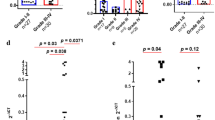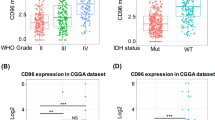Abstract
Standard treatment regimen of gliomas has almost reached a bottleneck in terms of survival benefit. Immunotherapy has been explored and applied in glioma treatment. Immunosuppression, as a hallmark of glioma, could be alleviated by inhibiting certain abnormally expressed biomarkers. Here, transcriptome data of 325 whole grade gliomas were collected from the CGGA database. The TCGA RNA sequencing database was used for validation. Western blot was used to verify the expression level of VAT1 on cellular level. The results showed that the expression of VAT1 was positively correlated with the grades of glioma as classified by WHO. A higher expression level of VAT1 was observed in the mesenchymal subtype of gliomas. The area under the curve suggested that the expression level of VAT1 might be a potential prognostic marker of mesenchymal subtype. In survival analysis, we found that patients with high VAT1 expression level tended to have shorter overall survival, which indicated the prognostic value of VAT1 expression. The results of gene ontology analysis showed that most biological processes of VAT1-related genes were involved in immune and inflammatory responses. The results of GSEA analysis showed a negative correlation between VAT1 expression and immune cells. We also identified that the expression of immune checkpoints increased with VAT1 expression. Therefore, the high expression level of VAT1 in patients with glioma was a potential indicator of a lower survival rate for patients with gliomas. Remarkably, VAT1 contributed to glioma-induced immunosuppression and might be a novel target in glioma immunotherapy.






Similar content being viewed by others
Abbreviations
- CGGA:
-
Chinese Glioma Genome Atlas
- DA:
-
Dopamine
- GBM:
-
Glioblastoma
- GO:
-
Gene ontology
- GSEA:
-
Gene set enrichment analysis
- GSVA:
-
Gene set variation analysis
- IDH:
-
Isocitrate dehydrogenase
- Mfn:
-
Mitofusin
- NK:
-
Natural Killer
- OS:
-
Overall survival
- siRNA:
-
Small interfering RNA
- TCGA:
-
The Cancer Genome Atlas
- TMZ:
-
Temozolomide
- VAT1:
-
Vesicle amino transport protein 1
References
Jiang T, Mao Y, Ma WB et al (2016) CGCG clinical practice guidelines for the management of adult diffuse gliomas. Cancer Lett 375:263–273. https://doi.org/10.1016/j.canlet.2016.01.024
Louis DN, Perry A, Reifenberger G et al (2016) The 2016 World health organization classification of tumors of the central nervous system: a summary. Acta Neuropathol 131:803–820. https://doi.org/10.1007/s00401-016-1545-1
Weller M, Van dBM, Tonn JC, et al (2017) European association for neuro-oncology (EANO) guideline on the diagnosis and treatment of adult astrocytic and oligodendroglial gliomas. Lancet Oncol 18:e315–e329. https://doi.org/10.1016/S1470-2045(17)30194-8
Stupp R, Hegi ME, Mason WP et al (2009) Effects of radiotherapy with concomitant and adjuvant temozolomide versus radiotherapy alone on survival in glioblastoma in a randomised phase III study: 5-year analysis of the EORTC-NCIC trial. Lancet Oncol 10:459–466. https://doi.org/10.1016/S1470-2045(09)70025-7
Weller M, Cloughesy T, Perry JR, Wick W (2013) Standards of care for treatment of recurrent glioblastoma–are we there yet? Neuro Oncol 15:4–27. https://doi.org/10.1093/neuonc/nos273
Mohme M, Schliffke S, Maire CL et al (2018) Immunophenotyping of newly diagnosed and recurrent glioblastoma defines distinct immune exhaustion profiles in peripheral and tumor-infiltrating lymphocytes. Clin Cancer Res 49:4187–4200. https://doi.org/10.1158/1078-0432.CCR-17-2617
Lim M, Xia Y, Bettegowda C, Weller M (2018) Current state of immunotherapy for glioblastoma. Nat Rev Clin Oncol 15:422–442. https://doi.org/10.1038/s41571-018-0003-5
Pardoll DM (2012) The blockade of immune checkpoints in cancer immunotherapy. Natu Rev Cancer 12:252–264. https://doi.org/10.1038/nrc3239
Kim JE, Patel MA, Mangraviti A et al (2015) Combination therapy with Anti-PD-1, Anti-TIM-3, and focal radiation results in regression of murine gliomas. Clin Cancer Res 23:124–136. https://doi.org/10.1158/1078-0432.CCR-15-1535
Linial M, Levius O (1993) VAT-1 from Torpedo is a membranous homologue of zeta crystallin. FEBS Lett 315:91. https://doi.org/10.1016/0014-5793(93)81140-u
Mottaghi-Dastjerdi N, Soltany-Rezaee-Rad M, Sepehrizadeh Z et al (2016) Gene expression profiling revealed overexpression of vesicle amine transport protein-1 (VAT-1) as a potential oncogene in gastric cancer. Indian J Biotechnol 15: 161–165. http://nopr.niscair.res.in/handle/123456789/35550
Mori F, Tanigawa K, Endo K et al (2011) VAT-1 is a novel pathogenic factor of progressive benign prostatic hyperplasia. Prostate 71:1579–1586. https://doi.org/10.1002/pros.21374
Mertsch S, Becker M, Lichota A, Paulus W, Senner V (2009) Vesicle amine transport protein-1 (VAT-1) is upregulated in glioblastomas and promotes migration. Neuropath Appl Neuro 35:342–352. https://doi.org/10.1111/j.1365-2990.2008.00993.x
Shan X, Wang KY, Tong XZ et al (2009) High expression of VAT1 is a prognostic biomarker and predicts malignancy in glioblastoma. Oncol Rep 42:1422–1430. https://doi.org/10.3892/or.2019.7276
Bao ZS, Chen HM, Yang MY, Zhang CB, Yu K, Ye WL, Hu BQ, Yan W, Zhang W, Akers J et al (2014) RNA-seq of 272 gliomas revealed a novel, recurrent PTPRZ1-MET fusion transcript in secondary glioblastomas. Genome Res 24:1765–1773
Zhao Z, Meng F, Wang W, Wang Z, Zhang C, Jiang T (2017) Comprehensive RNA-seq transcriptomic profiling in the malignant progression of gliomas. Scientific data 4:170024
Amankulor NM, Kim Y, Arora S et al (2017) Mutant IDH1 regulates the tumor-associated immune system in gliomas. Genes Dev 31:774. https://doi.org/10.1101/gad.294991.116
Wei Y, Wei Z, Gan Y et al (2012) Correlation of IDH1 mutation with clinicopathologic factors and prognosis in primary glioblastoma: a report of 118 patients from China. PLoS ONE 7:e30339. https://doi.org/10.1371/journal.pone.0030339
Senbabaoglu Y, Gejman RS, Winer AG et al (2016) Tumor immune microenvironment characterization in clear cell renal cell carcinoma identifies prognostic and immunotherapeutically relevant messenger RNA signatures. Genome Biol 17:231. https://doi.org/10.1186/s13059-016-1092-z
Hu HM, Wang Z, Liu Y et al (2015) Genome-wide transcriptional analyses of Chinese patients reveal cell migration is attenuated in IDH1-mutant glioblastomas. Cancer Lett 357:566–574. https://doi.org/10.1016/j.canlet.2014.12.018
Wu F, Hu P, Li D, Hu Y, Qi Y, Yin B (2016) RhoGDIα suppresses self-renewal and tumorigenesis of glioma stem cells. Oncotarget 7: 61619–61629 https://doi.org/10.18632/oncotarget.11423
Li MY, Yang P, Liu YW, Zhang CB, Wang KY, Wang YY (2016) Low c-Met expression levels are prognostic for and predict the benefits of temozolomide chemotherapy in malignant gliomas. Sci Rep 6:21141. https://doi.org/10.1038/srep21141
Mohme M, Neidert MC, Regli L, Weller M, Martin R (2014) Immunological challenges for peptide-based immunotherapy in glioblastoma. Cancer Treat Rev 40:248. https://doi.org/10.1016/j.ctrv.2013.08.008
Basu S, Dasgupta PS (2000) Dopamine, a neurotransmitter, influences the immune system. J Neuroimmunol 102:113–124. https://doi.org/10.1016/s0165-5728(99)00176-9
Van Meir EG, Hadjipanayis CG, Norden AD, Shu HK, Wen PY, Olson JJ (2010) Exciting new advances in neuro-oncology: the avenue to a cure for malignant glioma. CA A Cancer J Clinic 60:166. https://doi.org/10.3322/caac.20069
Sampson JH, Heimberger AB, Archer GE et al (2010) Immunologic escape after prolonged progression-free survival with epidermal growth factor receptor variant iii peptide vaccination in patients with newly diagnosed glioblastoma. J Clin Oncol 28:4722–4729. https://doi.org/10.1200/JCO.2010.28.6963
Foreman PM, Friedman GK, Cassady KA, Markert JM (2017) Oncolytic virotherapy for the treatment of malignant glioma. Neurotherap 14:1–12. https://doi.org/10.1007/s13311-017-0516-0
Topalian SL, Hodi FS, Brahmer JR et al (2012) Safety, activity, and immune correlates of Anti–PD-1 antibody in cancer. N Engl J Med 366:2443–2454. https://doi.org/10.1056/NEJMoa1200690
Brown CE, Badie B, Barish ME et al (2016) Bioactivity and safety of IL13Rα2-redirected chimeric antigen receptor CD8+ T cells in patients with recurrent glioblastoma. Clin Cancer Res 21:4062–4072. https://doi.org/10.1158/1078-0432.CCR-15-0428
Stupp R, Taillibert S, Kanner A et al (2017) Effect of tumor-treating fields plus maintenance temozolomide vs maintenance temozolomide alone on survival in patients with glioblastoma: a randomized clinical trial. JAMA 318:2306–2316. https://doi.org/10.1001/jama.2017.18718
Luke JJ, Flaherty KT, Ribas A, Long GV (2017) Targeted agents and immunotherapies: optimizing outcomes in melanoma. Nat Rev Clin Oncol 14:463–482. https://doi.org/10.1038/nrclinonc.2017.43
Belcaid Z, Phallen JA, Zeng J et al (2014) Focal radiation therapy combined with 4–1BB activation and CTLA-4 blockade yields long-term survival and a protective antigen-specific memory response in a murine glioma model. PLoS ONE 9:e101764. https://doi.org/10.1371/journal.pone.0101764
Sakuishi K, Apetoh L, Sullivan JM, Blazar BR, Kuchroo VK, Anderson AC (2010) Targeting Tim-3 and PD-1 pathways to reverse T cell exhaustion and restore anti-tumor immunity. J Exp Med 207:2187–2194. https://doi.org/10.1084/jem.20100643
Woo SR, Turnis ME, Goldberg MV et al (2012) Immune inhibitory molecules LAG-3 and PD-1 synergistically regulate T cell function to promote tumoral immune escape. Cancer Res 72:917–927. https://doi.org/10.1158/0008-5472.CAN-11-1620
Omuro A, Vlahovic G, Lim M et al (2017) Nivolumab with or without ipilimumab in patients with recurrent glioblastoma: results from exploratory phase 1 cohorts of CheckMate 143. Neuro Oncol 20:674–686. https://doi.org/10.1093/neuonc/nox208
Johnston RJ, Comps-Agrar L, Hackney J et al (2014) The immunoreceptor TIGIT regulates antitumor and antiviral CD8(+) T cell effector function. Cancer Cell 26:923–937. https://doi.org/10.1016/j.ccell.2014.10.018
Zhang HG, Grizzle WE (2011) Exosomes and cancer: a newly described pathway of immune suppression. Clin Cancer Res 17:959–964. https://doi.org/10.1158/1078-0432.CCR-10-1489
Robbins PD, Morelli AE (2014) Regulation of immune responses by extracellular vesicles. Nat Rev Immunol 14:195–208. https://doi.org/10.1038/nri3622
Arreola R, Alvarezherrera S, Pérezsánchez G et al (2016) Immunomodulatory effects mediated by dopamine. J Immunol Res 2016:3160486. https://doi.org/10.1155/2016/3160486
Ilani T, Strous RD, Fuchs S (2004) Dopaminergic regulation of immune cells via D3 dopamine receptor: a pathway mediated by activated T cells. FASEB J 18:1600–1602. https://doi.org/10.1096/fj.04-1652fje
Eura Y, Ishihara N, Oka T, Mihara K (2006) Identification of a novel protein that regulates mitochondrial fusion by modulating mitofusin (Mfn) protein function. J Cell Sci 119:4913. https://doi.org/10.1242/jcs.03253
Hayess K, Kraft R, Sachsinger J et al (2015) Mammalian protein homologous to VAT-1 of Torpedo californica: Isolation from Ehrlich ascites tumor cells, biochemical characterization, and organization of its gene. J Cell Biochem 69:304–315. https://doi.org/10.1002/(SICI)1097-4644(19980601)69:33.0.CO;2-V
Koch J, Foekens J, Timmermans M et al (2003) Human VAT-1: a calcium-regulated activation marker of human epithelial cells. Arch Dermatol Res 295:203–210. https://doi.org/10.1007/s00403-003-0421-8
Simula L, Nazio F, Campello S (2017) The mitochondrial dynamics in cancer and immune-surveillance. Semin Cancer Biol 47:29–42. https://doi.org/10.1016/j.semcancer.2017.06.007
Buck MD, O’Sullivan D, Klein Geltink RI et al (2016) Mitochondrial dynamics controls T cell fate through metabolic programming. Cell 166:63–76. https://doi.org/10.1016/j.cell.2016.05.035
Funding
This work was supported by funding from the National Natural Science Foundation of China (No. 81903060) and Beijing Tiantan Hospital Miaopu Project (No. 2017MP05).
Author information
Authors and Affiliations
Contributions
PY, KYW, and XS designed the research. CBZ and ZLW helped with the data analysis. PY and QL performed the experiments. KYW and XS assisted with the experiments. JFW and TJ did the surgeries. PY wrote the original draft. All authors reviewed and edited the final manuscript.
Corresponding authors
Ethics declarations
Conflict of interest
The authors declare no competing financial interests.
Additional information
Publisher's Note
Springer Nature remains neutral with regard to jurisdictional claims in published maps and institutional affiliations.
Supplementary information
262_2021_2865_MOESM1_ESM.pdf
Supplementary Fig.1 GSVA analysis of data from the CGGA (A) and TCGA (B) databases showing the correlation between VAT1 expression and the expression of dopamine-related pathways. (PDF 3953 kb)
262_2021_2865_MOESM2_ESM.pdf
Supplementary Fig.2. GSEA analysis of data from the CGGA database showing the immune checkpoint-related pathway enrichment status of VAT1 positively correlated genes. Enrichment status of CTLA-4-related signaling pathway (A), PDCD1-related pathway (B), LAG3-related pathway (C), and PDCD1LG2-related pathway (D). The NES value is greater than 2 and FDR q value is less than 0.05 in all figures. (PDF 1265 kb)
262_2021_2865_MOESM3_ESM.pdf
Supplementary Fig.3 (related to Figure 6A) A demonstration of full-length gels and blots in western blot analysis. (PDF 288 kb)
Rights and permissions
About this article
Cite this article
Yang, P., Wang, K., Zhang, C. et al. Novel roles of VAT1 expression in the immunosuppressive action of diffuse gliomas. Cancer Immunol Immunother 70, 2589–2600 (2021). https://doi.org/10.1007/s00262-021-02865-z
Received:
Accepted:
Published:
Issue Date:
DOI: https://doi.org/10.1007/s00262-021-02865-z




